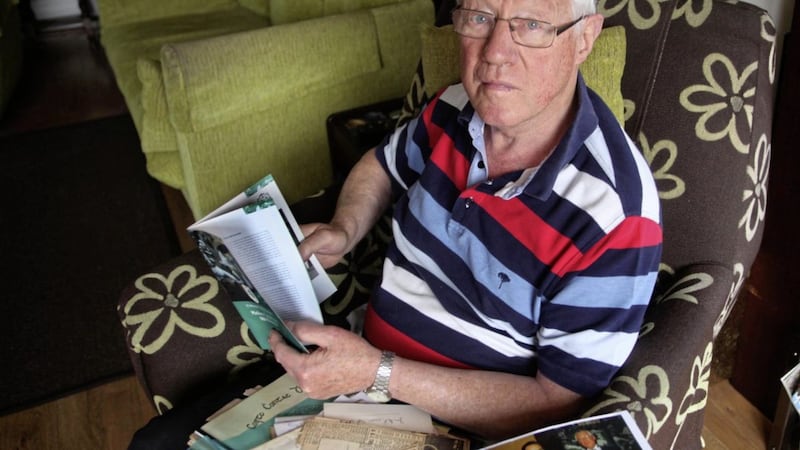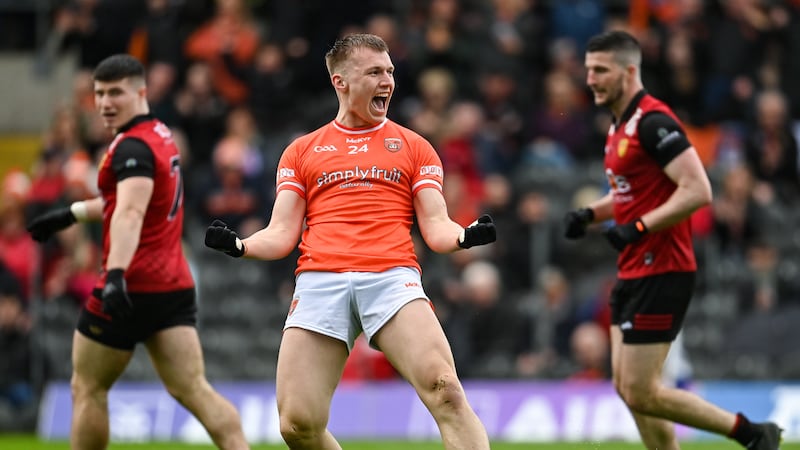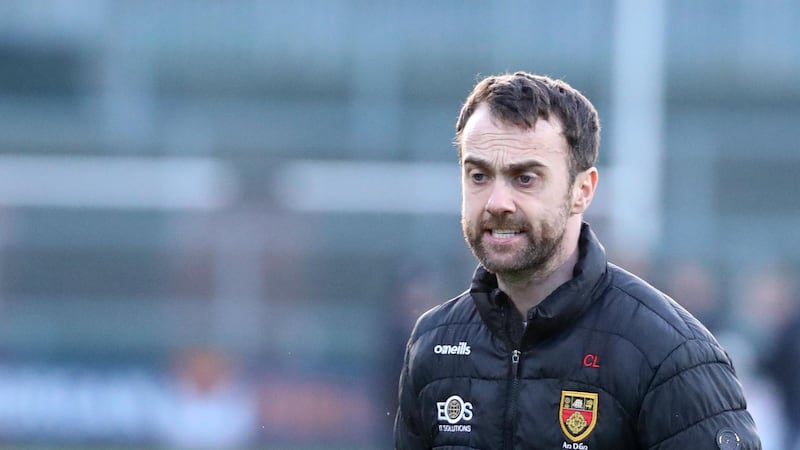AS you approach the door at the bottom of one of a hundred alcoves in the heart of west Belfast, there’s no house number to guide you.
But as you step through the gate next to number 54, there are two giveaways that this is the home of former Derry midfielder Phil Stuart.
Two stickers in the front windowpane. One shows a big red heart with the word ‘Gaeilge’ along the bottom. The other a red and white ‘Doire’ sticker, the top left-hand corner enough peeled to know that it’s been there since 1993.
That year’s team will forever be regarded as the ultimate in Derry football but 35 years earlier, a group of pioneers took on the might of Kerry and Dublin, and almost scaled the mountain first.
Phil Stuart was at midfield alongside friend Jim McKeever as Derry stunned the Kingdom in the All-Ireland semi-final of 1958.
Born in the tiny townland of Druminard, the last one west in Ballinderry before you enter Loup territory on the shore of Lough Neagh, Stuart was never too fond of the family farm.
His father Charlie had inherited it when the uncle he had been reared with, Tommy Keatley, died. The young Phil did his share but the heart wasn’t it.
“As I was told by local fellas, my hands were too much bothered with the pen for pulling flax.”
Thankfully for him, his father’s interest wasn’t much stronger. They sold up in 1955 and bought over what was McKee’s pub in Ballinderry but by that stage, he was on the rare path of education.
In his book ‘Stepping Stones’, Seamus Heaney recalls his mother being told by Mr Murphy in Anahorish school that he wanted Seamus to take the ‘new examination’.
Two years his senior, the same conversation was had between Mr Wallace in Ballinderry school – to where he walked three miles each day – and Phil Stuart’s mother.
The 11-plus sorted, he was shipped off to St Patrick’s Armagh to board.
“It was lonely, tough at times. Quite Spartan, but not, I believe, as tough as St Columb’s.
“The day boys used to bring things in for us, sweets and things.”
Football was his release. They played six days a week, resting on Sundays. He knew the school’s reputation. They had won four straight MacRory Cups between 1944 and ’47.
As a college footballer, the name wasn’t long in being noticed around home. The Loup men landed to the street at home first, looking to sign him up, but his friends were in Ballinderry, so that’s where he went.
Although only a sub on the team in 1953 MacRory Cup winning team, it was the beginning of a love affair with the competition.
From St. Patrick’s he went to Maynooth for two years, where John Hume was among his classmates, but it never agreed with him or he with it.
Football and the Irish language were his two loves at the time. He switched allegiances back to Belfast, moving to Queen’s in 1956, the same year he made his debut for Derry.
He would study for four years and had just finished when the new St. Patrick’s school opened in Maghera in the autumn of 1960. They offered him a job. A house was going in Magherafelt. Life at ‘home’ was set on a platter.
But his love was in Belfast. His friends, most notably Jim McKeever and Tom Scullion, had planted roots in west Belfast. McKeever lived two streets down. Holy Child primary school was around the corner and offered him a foot-up. He took it.
He would return home for the four summers but that was to be the last of his living in Ballinderry. He met his wife of 53 years, Lila, and they were married on June 27, 1964.
There was rarely a glance in the rear-view mirror, despite the smoky haze that the Troubles threw down upon the community he adopted, and from which his wife came.
Lila was raised just off the Falls Road, the 11th of 13 children in the Rooney household.
In July 1976, her brother Seamus was shot dead in the greengrocer’s shop he owned on the Upper Newtownards Road, where he would have served customers of all denominations.
At the inquest into his death, an RUC constable said: “He was the sort of person who would rather have done a person a good turn than a bad one, and was very popular.”
It could have been just as dangerous at home. He fondly recalls his battles and friendship with Bellaghy’s Willie Strathern: “Every ball was literally 50-50, I could never get the better of him”.
Strathern was a fine footballer for club and county, but was lured to his death in 1977 when he answered a late-night call for medicine for a sick child at his shop in Ahoghill, and was shot when he answered the door.
The lure of Ballinderry was never strong enough to pull the Stuarts from the city. Their four children told their parents that they had no interest in allowing themselves to be sucked through the whirlpool of destruction that caught so many at that time.
Despite all that was going on around them, they felt safe where they were. Because of his involvement in the Irish language, Phil regularly received post addressed in Irish. In a different part, that could have spelled danger, but there was a trust and a safety about their own little corner.
“Half of my classmates are out there in the green hillside along with the brave and the bold. Every time I’d lift The Irish News in the 1970s, there was another one in it,” he recalls.
* * * * * * * * * * * * * * * *
THIS was all post-football, which he played up until the late 60s.
The Belfast-based men would travel together for Derry training sessions and games, and in a remarkable commitment at the time, they continued to play for their clubs at home.
“I never joined a club here. When I finished with Queen’s, Rossa and St John’s came looking me, but I decided I was staying with Ballinderry. Most people would have done that because Antrim football didn’t appeal to Derry boys or Down boys.”
And so he took off after mass every Sunday and drove down to pull on the famous white and blue of Ballinderry.
At that time, though, it was a somewhat thankless task.
They hadn’t won a senior championship since 1927 and didn’t look to be getting any closer during his playing days.
A young Adrian McGuckin recalls standing at the gates of the old field and waiting on the lime green Volkswagen Beetle to come into view. When it arrived, it meant that “two-thirds of the team” had come in the form of one 5’11” man.
Memories of carnival games stand out in the mind, and he still holds dear to a “beautiful” medal won at Magherafelt Carnival that he keeps on a bracelet with his Lagan and McKenna Cup medals.
Then there were the meetings with their loughshore neighbours. The spectators longed for Ballinderry’s meetings with Ardboe and Moortown, but Stuart didn’t.
“I feared for my life. There were women on the sidelines shouting ‘Get Stuart, get the county man! Bog the shoe in him, there’s plenty more in Eastwoods’,” which was a shoe shop in Cookstown at the time.
“For the Tyrone boys to humble a Derry man like me would have been a feather in their cap.”
He brought the curtain down on his playing days when he was just shy of 30 in 1966. He and Lila had started a family in Belfast and the decision had to be made.
That was the end of his playing days but in the decade that he turned out for Derry, he left an indelible mark in the number 9 shirt.
He had the rare achievement of playing for the county’s minor, junior and senior teams in one year in 1956, and quickly became a focal point of the senior side at midfield.
They reached the Ulster final in 1957 and the following year, they would blaze a trail that would leave roots deep through the Oak Leaf county.
“We had a reasonably good team in ’57 and we decided there was something there in ’58. We got invited to the Wembley tournament and that particular exercise – Jim McKeever said the same – of going off to London together bred a camaraderie that wasn’t there before.
“Before that, we were just a representative team of our clubs. This thing bred some sort of camaraderie and made us into a team. That’s why we succeeded like we did in ’58.”
That Wembley occasion came on the Whit weekend in late May ’58 as a result of having beaten Tyrone for the right to travel to London.
It was the first Wembley games, which were designed to bring the game to ex-pats that had emigrated for work. Over 40,000 turned out and it became an annual tradition until the 1970s.
Having won Ulster for the first time in the county’s history just over a month after Wembley, a Kerry side containing the likes of Mick O’Connell and Mick O’Dwyer and John Joe Sheehy was supposed to be a bridge too far.
And at 1-2 to 0-1 down early on, it seemed that was the case. But Derry fought their way back to dominate much of the rest of the game and claim an unprecedented 2-7 to 2-6 win.
That put them into the final against Dublin and again a slow start didn’t help. They found themselves four down at the break but when the late Owen Gribbin poked home a rebound early in the second half to draw Derry level at 1-6 to 0-9, hope sprang eternal.
But Dublin finished stronger and the Oak Leafers were left to rue what they felt were some key decisions by referee Simon Deignan.
In those days goalkeepers weren’t permitted to pick the ball off the ground and the most notable decision was the one not to award a penalty when Dublin ‘keeper Paddy O’Flaherty pounced on the ball with two red and white shirts waiting to tap it into the net.
“I started arguing with Deignan and I always thought I should have captured the ball and refused to hand it up, and made a scene, and embarrassed him. Too naïve to do things like that in an All-Ireland.
"Owen Gribbin had been mauled by the Dublin full-back the whole time, he was on his back, and we got one 14-yard free.
“Dublin got shorts frees which Ollie Freaney tapped over the bar from all over the place.
”You’re lucky if you get one chance in your lifetime to play in an All-Ireland final. We got that chance, but we were never going to win it.”
The whole experience left Stuart raw. The runner-up plaque is on display at his home and while he would have loved to have won an All-Ireland, it was Leo O’Neill’s omission from the team for the final that hurt him most.
“I remember sitting beside Leo in the changing room after it and saying it wasn’t all that hard to get to. Leo was taking it very bad because he’d been dropped for the final, even though he scored a goal in the semi-final against Kerry.
“I gave an interview to Jim Davey, who came to Queen’s one day, and I said that Leo O’Neill should have been corner-forward. It was a bit indiscreet but I felt so bad for him.
“Leo O’Neill was a nippy corner-forward, a speed merchant. He won the 100 yards and 200 yards in the sports at St Columb’s. I saw him in Croke Park one day taking the ball and two Kerry men pulled out of the chase. Couldn’t catch him. He was brilliant. That was a particularly annoying thing.”
Derry never hit those heights again during his playing days, with a few Lagan and McKenna Cups in the early 1960s and those two unsuccessful National League finals the height of it.
Just short of 60 years on, Phil Stuart’s memories are vivid and hearty. A fine, fresh man, “it’s the way he’s looked after”, Lila deadpans.
The laughter keeps them young, clearly. And as Phil Stuart walks out to the gate to bid farewell two hours later on a fine Wednesday afternoon, there's a mixture of wistful and wispy about him as he stands to watch the car go out before turning back for the front door that gives the game away.
The Irish language and Derry football. What greater loves could there be?








